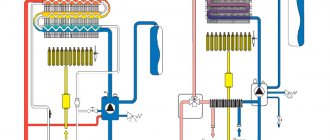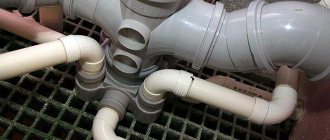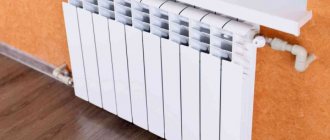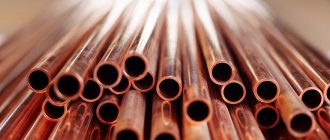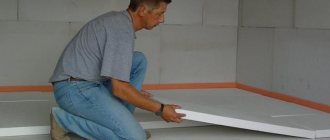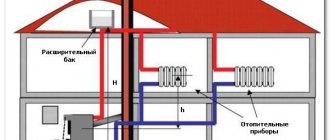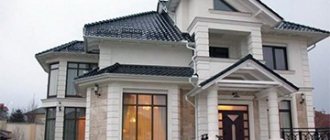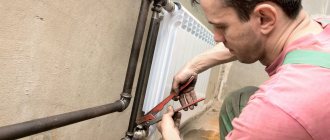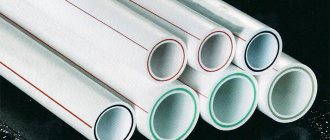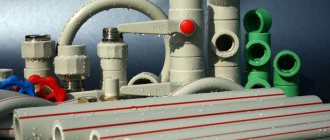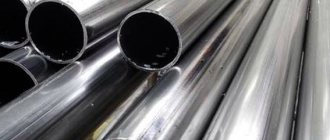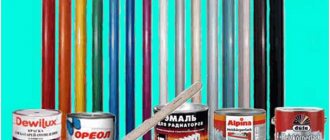Menu:
- Technical characteristics, advantages and disadvantages
- Using corrugation
- Calculations
- Popular questions and answers to them
- Briefly about the cost where to buy
- Installation and fastening
- Welding
- Connection of metal and plastic pipes
- Docking with fittings
- Video
Creating a heating circuit is quite a complex task. To solve this problem, metal pipes are traditionally used. They have excellent performance characteristics. Despite the emergence of polymer analogues, metal structures do not lose their popularity. Because they can withstand high temperatures and have high strength.
Technical characteristics, advantages and disadvantages
The properties of steel products depend on many factors. These include the production method and the characteristics of the steel grade used. Products are divided into welded and seamless. The first type is connected by welding. The second option is produced using special machines.
The key advantages of the products are:
- Availability. The price of metal heating pipes is relatively low.
- High strength. Circuits with a significant internal pressure are constructed exclusively from steel channels.
- Good gas tightness. This indicator for the products in question is very high. It plays a vital role in the construction of the heating circuit.
- Low thermal expansion. Therefore, there is no need to use thick-walled structures to install a heating system.
- Significant thermal conductivity. The metal gives off a significant amount of heat to the environment. Therefore, using steel products it is possible to make a heating system even without the use of radiators.
Metal channels also have disadvantages. They must be taken into account when arranging pipelines.
The disadvantages of the products in question include:
- High electrical conductivity. This imposes certain restrictions when arranging a heating circuit based on an electric boiler.
- Considerable rigidity. Bending structures can only be done by exposure to high temperature. To install the system, you need to use special fittings.
- Heavy weight. This complicates the transportation and installation of structures.
- Low resistance to corrosion processes. To avoid problems caused by oxidation, it is advisable to use galvanized or stainless steel.
Black steel products
There are several types of metal channels.
They can be made from the following types of steel:
- black;
- stainless;
- galvanized.
Products made of black steel were in great demand in the second half of the last century. As a rule, water-gas electric-welded structures were used to create a heating circuit.
Their properties are regulated by the state. standard 3262-75.
Below you can see the table of pipe sizes.
Today, designs with a diameter from six to one hundred and fifty millimeters are popular. There are products with larger cross-sectional sizes.
The key disadvantage of products made of black steel is their poor resistance to corrosion processes. As a result of oxidation, rust flakes and various unwanted deposits appear inside the products. All this negatively affects channel capacity.
The cost of such structures is quite low. But the duration of their operation also leaves much to be desired.
Galvanized products are resistant to rust. Therefore, their service life is significantly longer than that of the previous type of product. Moreover, the zinc layer only slows down the oxidation processes.
Galvanized ducts have more acceptable characteristics for creating heating circuits. They withstand pressure changes and high temperatures. Ideal for creating a central heating circuit. To install autonomous systems based on gas boilers, it would be more reasonable to use structures made of polymer materials.
Galvanizing also has disadvantages. During welding work, the zinc layer is damaged. Therefore, rust will inevitably occur in this place, which will have an extremely negative impact on the operation of the entire system. In addition, galvanized channels have a higher cost than products made of black steel or polymers.
Stainless steel is one of the best options for arranging heating pipelines. Such designs are durable. They are highly resistant to oxidation processes and have a significant safety margin. The disadvantages include the complexity of installing such channels and the high cost.
Classification of metal pipes
Among the types of metal pipes are:
- Stainless steel pipes. This is a reliable option for a variety of reasons. This material has a colossal service life, which approaches 100 years. Stainless steel is not subject to corrosion. The strength of the steel is at a high level and can withstand tests according to safety criteria. The attractive appearance of these pipes produces an additional effect on the buyer. But there are still some downsides. First of all, this is the price: steel pipes are the upper price segment on the market. Installation is also more expensive.
- Steel pipes. Pipes of this category are durable, thermal conductivity is high, which is important for heating systems. The service life is shorter than that of stainless steel pipes, but also quite long. The main disadvantage of steel is metal corrosion. With prolonged use, a layer of rust forms, which affects the quality of water. Blockages in pipes also occur for this reason. Steel pipes are in the budget segment and are often chosen for heating, but you need to be prepared for future replacement.
- Galvanized pipes. This type differs from steel ones by the presence of an additional zinc coating. This layer is necessary to protect against rust formation.
Note! It will not be possible to completely avoid corrosion on steel pipes, but it is still quite possible to slow down its formation by using various anti-corrosion coatings.
- Copper pipes. The advantages of using this type of pipe are due to the characteristics of copper. The metal is practically not afraid of corrosion, and with proper installation it lasts a very long time. The elasticity of copper allows you to install pipes in hard-to-reach places. High temperature changes are not a problem for copper pipes; they do not crack at low temperatures. Copper has bactericidal properties, which increases the quality of the resulting water. The only disadvantages include instability to mechanical stress; external damage very quickly wears out the surface of the pipes.
We recommend that you familiarize yourself with: Spiral-wound air duct designs
Using corrugation
Corrugated stainless steel structures are a good material for arranging heating systems in a private house or apartment. Products can have a diameter from fifteen to thirty-two millimeters. Corrugations with a larger cross-section can be made to order.
The products in question can withstand temperatures over a wide range. Corrugation can be used at temperatures from -40 to +800 degrees. It is obvious that these designs are not applicable in such conditions. Plastic fittings used during installation can withstand temperatures up to one hundred and ten degrees.
Corrugated structures are characterized by high resistance to physical damage and pressure changes. Such products can withstand exposure to up to fifty atmospheres. In this case, the operating pressure is fifteen atmospheres.
Please note that flexible products are completely oxygen impermeable. In this case, the value of the roughness coefficient is only 0.008. If you follow the rules for using these structures, their service life will be at least twenty years.
Using corrugation has a number of advantages.
These include:
- environmental friendliness of products;
- long service life;
- significant length of measured segments, allowing you to create long sections without fittings;
- slight noise;
- low weight;
- ease of installation;
- resistance to mold and fungi;
- excellent smoothness of the internal walls, ensuring high permeability of the channels;
- resistance to temperature and pressure changes;
- high anti-corrosion properties and inertness to chemicals;
- good heat dissipation;
- significant strength;
- ideal design flexibility.
Thanks to its excellent technical characteristics, corrugation is widely used in heating systems. However, it is worth remembering the disadvantages of the type of steel pipes under consideration. These include:
- the need to provide protection from electrochemical corrosion processes;
- the thinness of the design and its poor resistance to physical influences (you need to install a special protective box);
- high heat transfer rates;
- the ability to accumulate dirt in the recesses between the ribs of the corrugation;
- significant cost.
Heating installation with iron pipes
Heating installation with iron pipes is highly reliable. They are able to withstand large temperature changes.
The advantages of using an iron pipe system are as follows:
- High level of strength;
- Rigidity that allows you to withstand highway slopes.
The disadvantages of iron pipes are as follows:
- Expensive;
- Complex and lengthy installation;
- Susceptibility to corrosive processes.
Installation of pipes should be carried out after studying the wiring system. You need to know exactly where the radiator, additional equipment and boiler are installed. It is necessary to select pipes with a maximum diameter that must correspond to the diameter of the boiler outlet or pipe. After this, you need to decide on the heating wiring diagram. For iron pipes, a two-pipe scheme is usually chosen. This scheme has an average value for material consumption and allows for uniform heating of the radiators.
Calculations
To create a heating system, you need to calculate the required power of the pipes. The reliability of the system will depend on this. It is important that during the winter season all rooms in a private house or apartment are heated evenly. This can be achieved by installing channels of sufficient diameter. To find out the required section size you need to use the following formula: D = sqrt ((314∙Q)/ (V∙DT)).
Below you will find out what these variables mean:
- sqrt – square root;
- DT is the temperature difference between the inlet and outlet;
- V is the speed of the carrier;
- Q—heat flow;
- D – internal diameter indicator.
To simplify the calculations, you can use the corresponding table. It will save time .
Installation features
Having purchased pipes for a heating system, it is necessary to carry out the installation correctly. Features to pay attention to:
- To correctly calculate the number of pipes, fittings, and other pipeline elements, you need to draw the location of the main elements on a sheet of paper.
- Consider which connections are best made - detachable or soldered. The former are better suited for open systems, the latter for closed systems.
- In a private house, a separate room should be equipped in which a heating boiler, shut-off valves, and pipeline openings will be located.
- Select in advance the radiators that will be located in the rooms. Their choice depends on the diameter of the tubes and the heated area.
- When installing, do not tighten the fastening nuts. This will cause connections to be lost.
- Threaded fasteners are covered with FUM tape before tightening.
Before putting the pipeline into operation, perform a test run to avoid leaks.
Pipe diameters
The diameter of the steel pipe for heating must be known exactly. This will allow you to calculate the amount of substance passing through the network. In domestic heating lines, such knowledge is no less important.
Specifications
For example, when repairing heating in a house, the diameter must be calculated so that in cold weather the whole house is heated evenly.
The following diameters are designated:
- Conditional. It is designated “conventional diameter” - Du. This is the nominal internal volume measured in inches.
- Nominal. These values are given in letters “nominal diameter” - Dn.
- External diameter. Products are classified on this basis. Small - from 5 to 102 mm. Medium - from 102 to 426. And large diameters from 426 or more.
- Wall thickness of workpieces. This accompanying indicator is also very important.
- Internal volume of steel products. And this indicator is one of the main ones. This applies to connecting elements of pipeline sections.
Different pipes are used in different areas of construction. In this regard, regulatory documents have been developed. For example, a table with indicated volumes. Special formulas are also used for calculations, which greatly simplifies the work and saves a lot of time.
Popular questions and answers to them
When installing heating systems, many people have typical questions.
Below we will answer the most popular of them:
- How to paint metal structures? To solve this problem, several types of paints are used: acrylic, alkyd enamel and water-dispersion. Each of the listed options is perfect for solving this problem.
- Should old Soviet pipes be replaced? If we are talking about black steel, then definitely. The service life of such structures is about twenty years. Accordingly, channels installed more than two decades ago need to be replaced with new ones.
- Plastic or metal products? If we are talking about creating an autonomous heating system in a private house or apartment, it is better to use polypropylene or metal-plastic channels. For central heating systems, metal must be used.
- What is the service life of iron structures? It all depends on the quality of the material. Black steel lasts up to twenty years. Galvanization can be used for thirty years. Stainless steel can last over fifty years.
Briefly about the cost where to buy
The price of metal structures is indicated either per meter or per ton. Be sure to pay attention to this point. The cost of metal channels varies over a very wide range. The price depends on the quality of the material, production technology, wall thickness and other properties of the product.
Structures made of black steel are the cheapest. Next comes galvanization, which costs a little more. Stainless steel is the most expensive. However, as you have already learned, pipes made from it are the most reliable. Corrugated stainless steel channels are the most expensive.
The easiest way to order the products in question is from companies specializing in the sale of rolled metal products. It is advisable to deal with structural manufacturers or their official dealers. This will allow you to purchase the products you need at an affordable price.
In some cases, it makes sense to buy used pipes. The main thing is that they are in good condition. When purchasing, be sure to ask for a certificate of conformity. This will allow you to avoid purchasing inferior products.
Installation and fastening
There are two methods of installing metal structures: welding and connection using fittings. Each of them has its own characteristics. Also, when installing heating systems with your own hands, it is important to correctly wire the radiators. This operation must be performed in stages, following the technology. Do not forget about the correct fastening of metal pipes to the wall.
To create bends and turns of the contour, it is better to use the appropriate shaped parts. It is not recommended to bend metal structures by welding. During this operation, the channel performance may deteriorate.
The combination of metal and plastic products also has its own characteristics. Below we will talk about this in more detail.
Diameter of steel heating pipes - table
Designers and installers have already selected the optimal ratio of thermal power and outer diameter of the heating plastic pipe (as in the manufacturers' catalogue).
- For 3000-5000 W - suitable with a diameter of 20 mm;
- 6000-9000 W - 25 mm;
- 10000-15000 W - 32 mm;
- 16000-21000 W - 40 mm;
- 22000-32000 W - 50 mm.
Here is a table that allows you to calculate the internal diameter of a pipeline with a minimum amount of time with a known thermal load on it.
| Inner diameter, mm | Heat flow (kW) at flow speed, m/s | ||
| 0,4 | 0,5 | 0,6 | |
| 12 | 3,7 | 4,6 | 5,5 |
| 15 | 5,75 | 7,2 | 8,6 |
| 20 | 10,2 | 12,8 | 15,3 |
| 25 | 16 | 20 | 24 |
| 32 | 26,2 | 32,7 | 39,2 |
| 40 | 40,9 | 51,1 | 61,3 |
| 50 | 63,9 | 79,8 | 95,8 |
These indicators are averaged and, especially if the thermal power is close to the boundary value, it is better to contact specialists. But with a high degree of probability it can be argued that if the required thermal power of the circuit is, for example, 12 kW (area about 120 sq. m.), then the wiring of the heating system with forced circulation must be carried out with plastic pipes with a diameter of 32 mm.
Previous post: Weight of a steel pipe with a diameter of 100 mm
Next entry: Polyethylene sewer pipes - purpose and characteristics
Welding
Traditionally, electric welding was used to connect metal channels. This operation allows you to reliably connect two products together. The quality of its implementation must be extremely high. The performance of the entire circuit depends on how well the joint is made. If the welding was done poorly, a leak may occur in the near future.
Connections by welding can be made:
- in the corner;
- end-to-end;
- vtavr;
- overlap
Note that when installing heating ducts, butt welding is predominantly used. This method allows you to create the most reliable joint. Therefore, always connect products exclusively end-to-end.
Connection of metal and plastic pipes
Structures made of steel and polymers are joined in two ways.
Combinations of products from different materials can be:
- Rezbovym.
- Flange.
For joining small structures, a threaded connection is most often used. For this purpose, special shaped parts are used, which consist of two parts. The first is a metal thread, and the second is a plastic coupling. In this way, a transition is made from one pipe to another. The joining method is suitable for channels with a cross-sectional size of up to forty millimeters.
The flange connection is permanent. It is used for large diameter structures. This connection allows you to quickly assemble or disassemble any section of the pipeline. The joining of metal-plastic or plastic structures to steel ones is carried out using special components - flanges.
The main types of pipes for heating a private house
Until recently, the choice of the type of pipes for water heating systems in a private house was not so relevant, since metal pipes, mainly steel, were almost universally used for this purpose. But nowadays, the range of pipes that can be used for this purpose has expanded significantly due to the use of synthetic materials. The main ones are the following:
- plastic - polypropylene and cross-linked polyethylene (PEX);
- metal-plastic;
- metal - steel or copper.
In order to determine with complete confidence which pipes are best to use for heating a house in each specific case, we will consider in more detail their pros and cons, as well as the features of installation and operation. And let's start with the currently quite popular plastic pipes.
Polypropylene pipes: advantages and disadvantages
The positive qualities of polypropylene pipes have made them quite popular. The following advantages can be highlighted:
Flaws
But along with the positive qualities, polypropylene pipes also have a number of disadvantages that must be taken into account when deciding to choose this type for the heating system of your home:
- To connect them, you need to use special equipment - a soldering iron. If the installation of the system is carried out by a specialist, then there is no problem. If you decide to do this work yourself, you will have to purchase or rent a soldering iron and learn how to use it to connect pipes to each other and to fittings. Although, in principle, this is not so difficult, soldering in any case must be done with high quality. Otherwise, if the pipe overheats, its internal diameter may decrease, and if it is underheated, it may leak, and not even immediately, but after some time.
- Such pipes bend slightly, so for turns it is necessary to use special shaped elements, which complicates the work, especially in areas with a complex configuration and many changes in the direction of the pipes.
- under the influence of high temperature, the rigidity of the pipe material decreases, it can sag (to prevent this, more frequent fastening is required), and some linear thermal expansion occurs (up to 1 mm per 1 m of pipe), which is required for hidden installation, as well as in at joints with rigidly fixed elements, install compensators (fittings in the form of a curved section of pipe).
- low resistance to high temperatures - the maximum operating temperature of the coolant should be no more than 70°C, with only a short-term increase to 90°C possible, which is a rather important drawback, especially in systems with solid fuel boilers.
- If the pipe is damaged in any section, it will have to be completely replaced between fittings.
Cross-linked polyethylene (PEX) pipes
Pipes made of this material (PEX), compared to polypropylene (especially non-reinforced ones), are more durable and also have the following positive characteristics:
higher than that of polypropylene pipes, the maximum operating temperature is up to 90°C. Great durability - their service life is up to 50 years. Convenience and ease of installation - you can connect without soldering, but use press fittings and threaded connections
PEX pipes have virtually no linear thermal expansion, this is especially important when they are hidden. they can be bent when heated, and when cooled they retain their given shape
In addition, when reheated, the pipes return to their original straight shape - the so-called “memory effect”.
Their disadvantages also include:
- instability of the material to ultraviolet radiation, although when installing the system inside the house this drawback is not significant.
- to connect them using press fittings, you need to purchase or rent a special press, the cost of which is quite high;
- PEX pipes are sold in coils and the cut pieces from them are not straight, but curved, and it is almost impossible to straighten them without heating, which causes inconvenience during installation.
